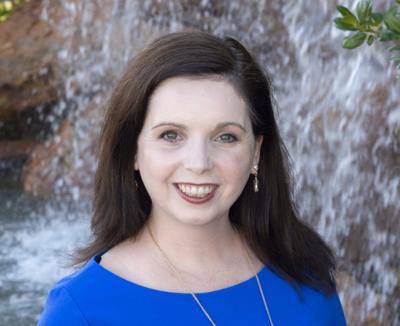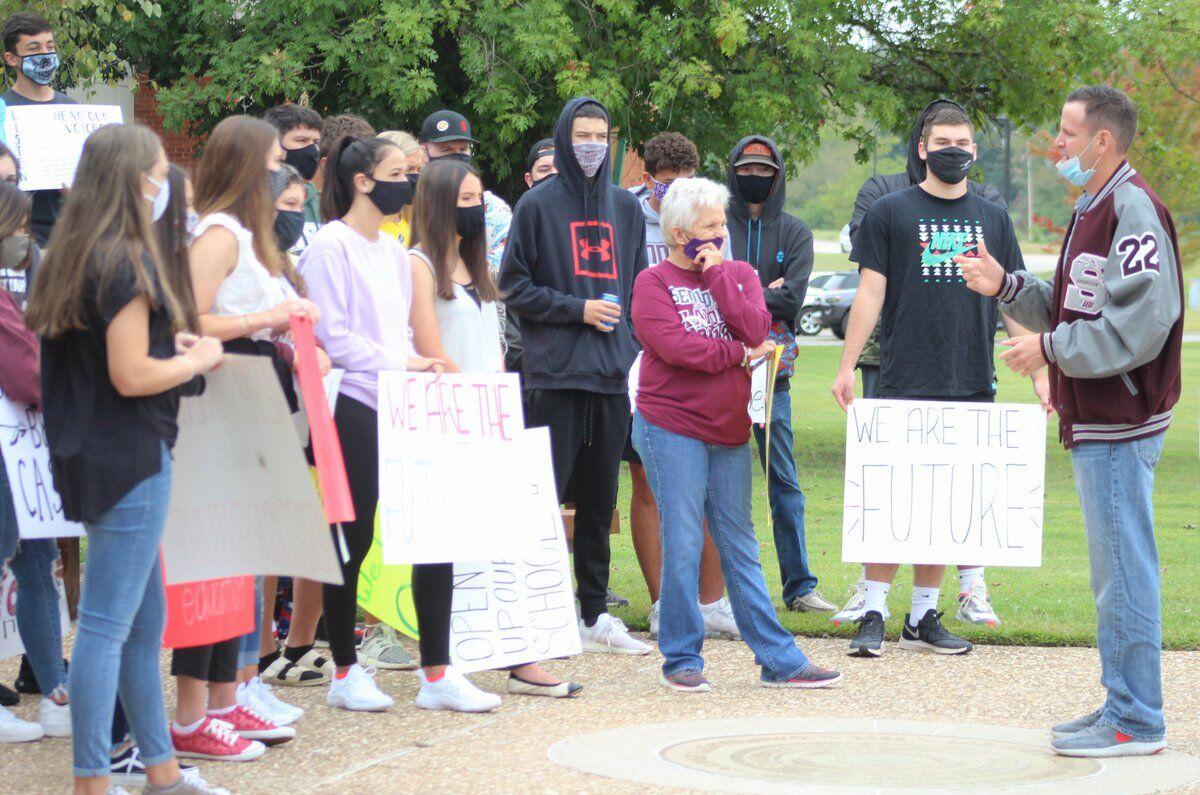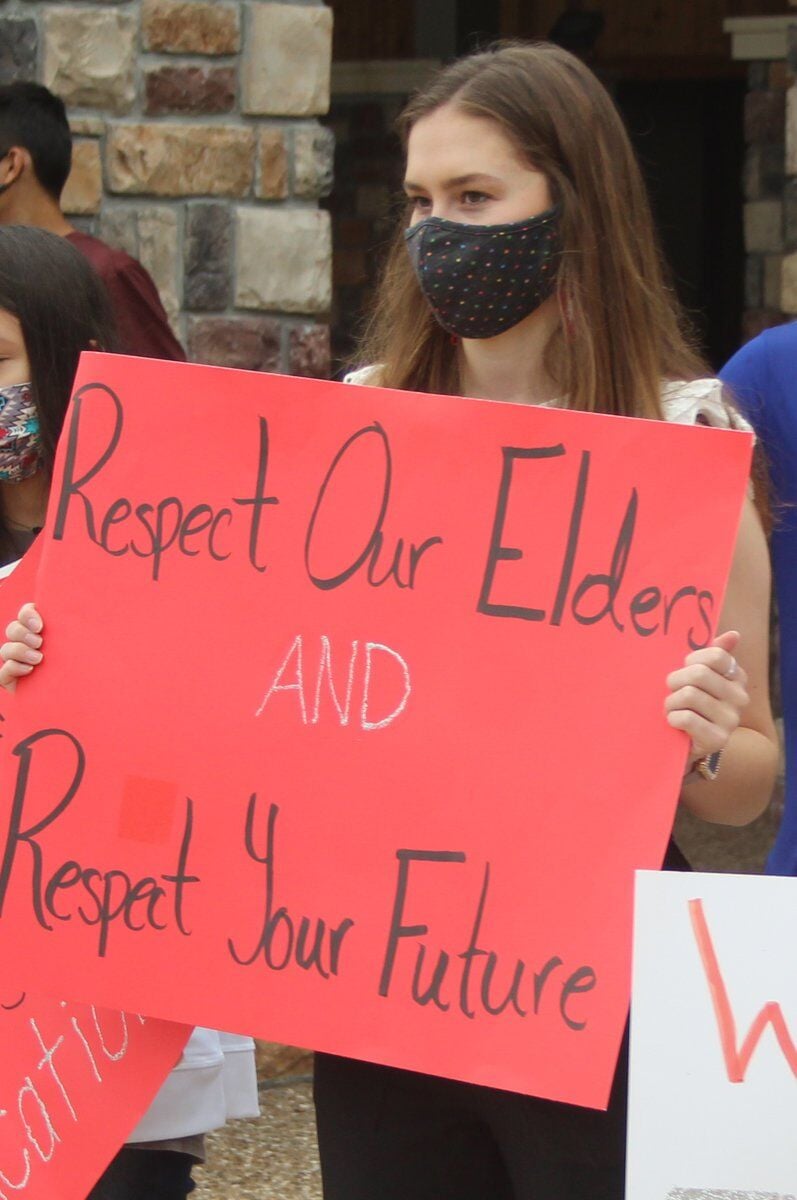By Ben Felder | The Frontier

Jena Nelson is the 2020 Oklahoma Teacher of the Year.
One after another, parents told the Deer Creek school board during a meeting Monday evening they wanted their children back in school five days a week as quickly as possible. Digital learning had caused grades to slip, social skills were being neglected and the COVID-19 risk to students was minimal, parents claimed.
Also addressing the board was Jena Nelson, a Deer Creek Middle School teacher and Oklahoma’s current teacher of the year, who implored the board not to make a hasty decision and to keep student and teacher safety in mind when deciding when to return to full in-person learning.
“We all want the same thing, we want our kids back in school with teachers who love them,” Nelson said. “But we cannot rush to make decisions on our emotions … or tried within the court of Facebook law.”
As Nelson returned to her seat, several parents in the audience booed and shouted at her.
School districts across Oklahoma continue to weight decisions about in-person learning as the state’s COVID-19 positivity rate remains one of the highest in the nation.
School administrators are also feeling increasing pressure from parents to fully reopen schools and allow sports teams to practice and play as normal.
In Edmond, where students attend school in-person just two days a week, parents gathered at the district administration building last week to protest against the blended learning model and to urge administrators to no longer require masks.
“Five days a week, no masks,” they shouted as they marched around the building.
Like Edmond, Deer Creek students have been in classrooms just two days a week. The board voted Monday to continue with the current plan after some of its members engaged in arguments with parents in the crowd.
In the rural Wynnewood school district, superintendent Tim Simpson recently apologized for ordering the quarantine of the high school softball team after parents complained.
I “took the decision out of our parents’ hands,” Simpson wrote on the district’s Facebook page.
The district originally told parents to make their own decisions on whether to send a child to school if they had been in contact with a person who tested positive.
But after the state Department of Education’s general counsel issued a letter to the district disputing that policy Wynnewood now requires students to quarantine after contact with a person with a known case of COVID-19.
At this week’s Deer Creek school board meeting, some parents argued children have a low risk of contracting the virus or developing severe symptoms. TRUMP TALKING POINTS
Children under the age of 17 make up 10 percent of all confirmed cases nationally, according to data compiled by the American Academy of Pediatrics.
In Oklahoma, children make up 11.3 percent of all cases.
“This data … underscores the urgent need to control the virus in our communities before our schools and businesses can safely reopen,” said Dr. Savannah Stump, a pediatrician, parent of two Deer Creek students and member of the Oklahoma State Medical Association’s COVID-19 task force.
Nelson, the state teacher of the year, said more needs to be considered than just he risk to students.
“Even if it’s true that kids have a lower risk they are still taught by adults,” Nelson told The Frontier. “Look at the median age for teachers (in Oklahoma), they are on the upper end. And then you start adding in teachers with underlying health issues and we have a big risk.”
Nelson worries a rush to return could result in a loss of many teachers at a time when the need for more educators is growing.
The state Board of Education has already approved 1,285 emergency teaching certificates this school year, more than double the number requested by school districts at this point last school year.
More than 200 school districts have reported cases of COVID-19, according to KOSU, which is tracking cases in public schools.
Health officials said the reopening of schools has contributed to the state’s recent rise.
“It’s mostly due to school reopening, universities are the main factor, we’ve also had some outbreaks in different congregate facilities,” like prisons, said interim Health Commissioner Lance Frye.
The Frontier is a nonprofit corporation operated by The Frontier Media Group Inc.
STUDENTS WANT CHOICE: Sequoyah High School students protest virtual learning only; want options
By Grant D. Crawford gcrawford@tahlequahdailypress.com

Grant D. Crawford | Daily Press
Sequoyah High School students protesting outside of the Cherokee Nation W.W. Keeler Complex Thursday were met by former tribal councilor David Walkingstick, far right.

Grant D. Crawford | Daily Press
Ryly Ziese helped organize a protest outside of the Cherokee Nation W.W. Keeler Complex Thursday.
Grant D. Crawford | Daily Press
A group of Sequoyah High School students protested their lack of choice to attend class in-person outside of the Cherokee Nation W.W. Keeler Complex Thursday.
A group of Sequoyah High School students stood outside of the Cherokee Nation W.W. Keeler Complex Thursday morning to protest the tribe's decision to close the school doors and continue with curriculum through virtual learning.
While area public schools have remained open, allowing students to choose whether to attend class in-person or online, Sequoyah High School decided to transition all of its students to virtual classes after two weeks of having them on campus. Equipped with signs, the protesters voiced their displeasure with not being given the option whether to attend class in-person. They gained support from District 3 Tribal Councilor Wes Nofire, who said they should have the same opportunities as public school students.
"They're the only school that's virtual only and a lot of students have already transferred out," said Nofire. "Some of those students transferred out with Fs, because virtual learning was not working and they were not getting another option to come in and learn."
As of Wednesday, the Cherokee Nation surpassed 2,000 positive COVID-19 cases within CN Health Services, and there are currently more than 400 active cases. The tribe has ordered more personal protective equipment, and touchless sinks, toilets and water fountains for when students can return to Sequoyah. However, Principal Chief Chuck Hoskin Jr., who commended the students for exercising their First Amendment rights to assemble, said that won't occur until the tribe sees improvement in coronavirus numbers.
"The decision, as it always is with our decision at Cherokee Nation in terms of COVID response, is based on medical science, facts, and compassion," said Hoskin. "The spread of the virus is and has been too dangerous to gather in school buildings, when we have the technology to do distanced learning. We have an opportunity to protect not only the kids, but the teachers and the staff; and not only the kids, the teachers and the staff, but those Cherokee elders that live in the communities where these kids call home."
While the group of students claimed they are taking the ongoing pandemic seriously, they also pointed to the surrounding schools that have students returning to class. Ryly Ziese, a senior at SHS, said they understood that not all people want to go back to school, but if they were given a choice, she thinks with certain precautions in place it could be done with minimal concerns.
"A lot of kids that are straight-A kids are failing because of the virtual stuff," she said. "Most teachers aren't prepared for virtual, so they don't know how to handle it. It's hurting the kids a lot more than people think, and we just want the chief to know that and give us the choice to go back to school."
For seniors, 2020-2021 is the last year to participate in extracurricular activities. Some students hope to receive athletic scholarships, which is difficult to do when there are no sports seasons to compete in. Asa Robbins, SHS senior, said she hopes to be able to compete in track this year, but wanted to clarify that their protest was not about getting students back on the field.
"A lot of people are thinking we're over here moaning about not getting to play sports, and that's not the scenario," said Robbins. "Right now we're focused on education first and sports second, because we have kids failing."
Robbins said she's heard of maybe 50 students who have already transferred out of Sequoyah, and that it seems like every day she has to tell a fellow classmate "best of luck."
Hoskin said he sympathizes with the students and wishes they could return to class, adding that it's regrettable when any student leaves SHS. However, he also said the number of transfers will not influence the tribe's decision when it comes to reopening the school, but will rather be dictated by the "science of the pandemic."
"Given the spread, we're not coming back anytime soon," he said.
"There would have to be a dramatic change in the statistics on COVID spread in our communities. I visit all the time with our public health staff and our other expert advisors to get input, but ultimately I have to do what I think is best to protect the well-being of the students and the communities where they live."
By Grant D. Crawford gcrawford@tahlequahdailypress.com

Grant D. Crawford | Daily Press
Sequoyah High School students protesting outside of the Cherokee Nation W.W. Keeler Complex Thursday were met by former tribal councilor David Walkingstick, far right.

Grant D. Crawford | Daily Press
Ryly Ziese helped organize a protest outside of the Cherokee Nation W.W. Keeler Complex Thursday.
Grant D. Crawford | Daily Press
A group of Sequoyah High School students protested their lack of choice to attend class in-person outside of the Cherokee Nation W.W. Keeler Complex Thursday.
A group of Sequoyah High School students stood outside of the Cherokee Nation W.W. Keeler Complex Thursday morning to protest the tribe's decision to close the school doors and continue with curriculum through virtual learning.
While area public schools have remained open, allowing students to choose whether to attend class in-person or online, Sequoyah High School decided to transition all of its students to virtual classes after two weeks of having them on campus. Equipped with signs, the protesters voiced their displeasure with not being given the option whether to attend class in-person. They gained support from District 3 Tribal Councilor Wes Nofire, who said they should have the same opportunities as public school students.
"They're the only school that's virtual only and a lot of students have already transferred out," said Nofire. "Some of those students transferred out with Fs, because virtual learning was not working and they were not getting another option to come in and learn."
As of Wednesday, the Cherokee Nation surpassed 2,000 positive COVID-19 cases within CN Health Services, and there are currently more than 400 active cases. The tribe has ordered more personal protective equipment, and touchless sinks, toilets and water fountains for when students can return to Sequoyah. However, Principal Chief Chuck Hoskin Jr., who commended the students for exercising their First Amendment rights to assemble, said that won't occur until the tribe sees improvement in coronavirus numbers.
"The decision, as it always is with our decision at Cherokee Nation in terms of COVID response, is based on medical science, facts, and compassion," said Hoskin. "The spread of the virus is and has been too dangerous to gather in school buildings, when we have the technology to do distanced learning. We have an opportunity to protect not only the kids, but the teachers and the staff; and not only the kids, the teachers and the staff, but those Cherokee elders that live in the communities where these kids call home."
While the group of students claimed they are taking the ongoing pandemic seriously, they also pointed to the surrounding schools that have students returning to class. Ryly Ziese, a senior at SHS, said they understood that not all people want to go back to school, but if they were given a choice, she thinks with certain precautions in place it could be done with minimal concerns.
"A lot of kids that are straight-A kids are failing because of the virtual stuff," she said. "Most teachers aren't prepared for virtual, so they don't know how to handle it. It's hurting the kids a lot more than people think, and we just want the chief to know that and give us the choice to go back to school."
For seniors, 2020-2021 is the last year to participate in extracurricular activities. Some students hope to receive athletic scholarships, which is difficult to do when there are no sports seasons to compete in. Asa Robbins, SHS senior, said she hopes to be able to compete in track this year, but wanted to clarify that their protest was not about getting students back on the field.
"A lot of people are thinking we're over here moaning about not getting to play sports, and that's not the scenario," said Robbins. "Right now we're focused on education first and sports second, because we have kids failing."
Robbins said she's heard of maybe 50 students who have already transferred out of Sequoyah, and that it seems like every day she has to tell a fellow classmate "best of luck."
Hoskin said he sympathizes with the students and wishes they could return to class, adding that it's regrettable when any student leaves SHS. However, he also said the number of transfers will not influence the tribe's decision when it comes to reopening the school, but will rather be dictated by the "science of the pandemic."
"Given the spread, we're not coming back anytime soon," he said.
"There would have to be a dramatic change in the statistics on COVID spread in our communities. I visit all the time with our public health staff and our other expert advisors to get input, but ultimately I have to do what I think is best to protect the well-being of the students and the communities where they live."
No comments:
Post a Comment